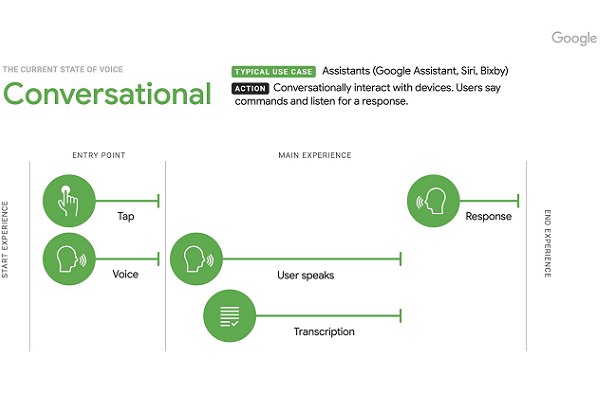Google Publishes Digital ‘Voice Playbook’ for Developers
 Google released an online booklet examining the ways people use voice technology. The Voice Playbook acts as a kind of style guide for the industry as it is and lays out ideas on how to build better voice tech that will attract even more people, especially on an international level, as part of Google’s Next Billion Users onboarding strategy.
Google released an online booklet examining the ways people use voice technology. The Voice Playbook acts as a kind of style guide for the industry as it is and lays out ideas on how to build better voice tech that will attract even more people, especially on an international level, as part of Google’s Next Billion Users onboarding strategy.
Google’s Guide
The VoicePlaybook covers a lot of ground, packing a ton of photos and graphs to break down how voice tech is used today in relatively simple terms. According to Google, voice interactions can be defined as recording, commands, conversational, and dictation. Each has its own flow, as illustrated at the top, albeit with a lot of possible permutations. But, as voice tech goes international, Google sees the tech as an integral element to getting people online who won’t use keyboards or touchpads. Some may have limited literacy, or they may get frustrated over the speed of typing in non-Latin characters, as a paragraph in Hindi takes three times as long as it would in English, according to Google. Voice can skip past those limits.
“It’s easy to think of the ability to talk to your phone as just a matter of convenience — a way of getting information while you’re driving or cooking. But for many new internet users, voice isn’t just helpful — it’s critical,” Google user experience director for Next Billion Users Asif Baki explained in a blog post. “And it makes the output they’re seeking — the result of a search query, for example — much easier to understand.”
Hushed Voice
That doesn’t mean there isn’t lots of room for improvement in voice tech, according to the playbook. Misinterpretation leads to frustration in audio as much as it does in text form, leading to people giving up on the tech. Voice tech also tends to raise privacy worries on an instinctive level. Speaking out loud means someone might hear you nearby, which may make some not want to engage with voice tech. That’s especially true if they are worried about how it looks to use voice instead of typing. The value of voice tech to people who may not be fully literate is that people may judge them as such, whether or not it’s true, because of their choice of interface. No one wants to be mocked or teased for something like that.
“Technology can pose challenges for voice users, but if it’s designed and built right, it can also help overcome them,” Baki wrote. “Drawing on the lessons we’ve learned with our own voice technology, we’ve created a set of principles to guide the industry forward and help technology-makers everywhere think about how to build for voice. When we understand people’s experience of voice, and build around that experience, we can dramatically improve the helpfulness and accessibility of the technology they use.”
Google’s Playbook has a bunch of suggestions for overcoming at least some of the brakes on the industry. A lot of the ideas are less about improving the tech and more about adapting it for more kinds of people. The list includes better icons, as in no more old microphones, getting the AI to speak slower and with shorter sentences, and improving how the AI grasps the pace and style of comfortable, natural speech.
“People are using voice because it makes the internet less complex and confusing. At the same time, there are still significant, often frustrating challenges that remain,” Baki wrote. “As hundreds of millions more people around the world come online, we want voice to feel more natural and useful. We’re looking forward to helping more people use their voice — and feel heard.”
Follow @voicebotai Follow @erichschwartz
Google Upgrades Conversational AI Intuition and Flexibility at Google I/O 2021 With LaMDA and MUM
Google Assistant Unveils New ‘Capabilities’ and ‘Widgets’ for Developers at Google I/O








